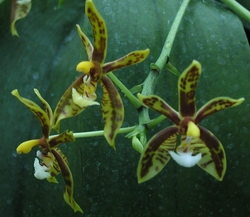|
Phalaenopsis
mannii (Rchb.f 1871)
|
| |
| |
 |
|
|
| |
|
Distribution
: India, Sikkim, Assam, Viet-nam
|
Principal
synonyms
|
Phalaenopsis boxallii
(Rchb.f 1883)
|
Polychilos mannii (Shim
1982)
|
|
|
| |
 |
|
Epiphytic
plant with very short stem, completely enclosed by imbricating leaf-sheaths.
Roots many, rather long, flexuous, glabrous.
Leaves more or less numerous (4/5),
drawn up or spread out, a little flask, obovate-oblong or oblanceolate-oblong,
abruptly acute, a little sickle-shaped, of a pale green, more or less
brown spotted, (especially toward the base),veined, long from 20 to
35 cm, wide from 4 to 7 cm.
Flower stalk as long or a little longer
than the leaves, erect or a little pendant, robust, hardly compressed,
green very finely punctuated of mauve, sometimes simple, more often
provided with 2 or 3 short branches, multiflores.
Bracts rigid, a little fleshy, very
concave, ovate-lanceolate, acute, green, long of 1 cm.
|
|
Flower spread out,
a little fleshy and rigid from 4 to 5 cm. Sepals very spread out,
convex, margin a little undulated and strongly revolutate, carrying
outside, close to the apex, a strong apiculate bulge. Dorsal sepal
linear-ligulate, sub-obtuse. Lateral sepals larger, lanceolate-sub-spatulate,
acute, strongly asymmetrical. Petals almost similar to the sepals,
but narrower and a little shorter, little thickened at apex, lanceolate-ligulate,
acute. |
|
 |
|
Lip half shorter than lateral
sepals. Lateral lobes erect, connivent, oblong-sub-quadrangular,
apex obliquely truncated. Midlobe anchor-shaped, with a little recurvate
arm, obtuse, finely denticulate and papillose towards the apex.
Disc between lateral lobes presenting a transverse callus flattened
fleshy surmounted of two long subulate appendices, divergent, and
in front of this callus a long erect appendix, obtuse, laterally
compressed.
Lengthened column, claviforme, basally provided on
each side of a small triangular tooth.
Pedicellate ovary of 3 cm.
|
|
 |
|
|
Observations
|
| |
Sepals
and petals yellow or of a white yellowish, tinted and mackled mauve/lilas.
White or a little yellowish lip. The appendix drawn up on the front of the
callus is purplish. The column yellow and striated a little with red. Lightly
scented.
Flowering is primarily in spring, but may be more spread
out. An adult plant is able to give 4/5 floral stalk each year.
Able to remain flowered more than three months and to
tolerate temperatures of 7°c without damage. It's growing at an altitude
close to 500 meters and up to 1400 meters, always in a very wet environment
bordering the 90%. The plants are from 4/5 meters to the ground, very in
the shade of the forest. Thus he needs a little less light in culture. In
its natural habitat, the temperatures can go down exceptionally behind the
point of frost.
Little cultivated in spite of its generosity. This
species produces very floriferous rejects. |
| |
|
Historique
|
| |
| This discovery is from Gustave
Mann working with the service of the administration of the forests of India
which made the first collection in May 1868. |
| |
|
Botanical
variety
|
Horticultural
varieties
|
| |
|
|
Phalaenopsis
Phalaenopsis mannii var.flava (Christ.2001)
Synonym: mannii var concolor (Trudel 1986)
Fleur smaller than the type, uniformly
yellow.
|
Phalaenopsis mannii
"Red"
New type. Plant more robust than the type. May be not a really natural
specie.
|
|
|
|
|
| |
|
|
| |
Average temperature humidity and
pluviometry, evolution relating to the north of India at an altitude
of 450 meters (area of Darjeling)
 |
 |
|
|
|
